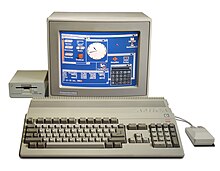
Back Amiga 500 AN أميغا 500 Arabic Amiga 500 German Commodore Amiga 500 Spanish Amiga 500 Basque آمیگا ۵۰۰ Persian Amiga 500 Finnish Amiga 500 French Amiga 500 Croatian Amiga 500 Hungarian
 A500 with 1084S monitor and Amiga 1010 external second floppy drive | |
| Developer | Commodore International |
|---|---|
| Product family | Amiga |
| Type | Home computer |
| Release date | April 1987 (Netherlands) May 1987 (Europe) October 1987 (US/UK) |
| Introductory price |
|
| Discontinued | 1992 |
| Units sold | 2.6 million[1] 1,160,500 units in Germany (including Amiga 500 Plus sales) |
| Media | 880 KB floppy disks |
| Operating system | AmigaOS v1.2 – 1.3 (upgradable to current version if enough RAM is installed) |
| CPU | Motorola 68000 @ 7.16 MHz (NTSC) 7.09 MHz (PAL) |
| Memory | 512 or 1024 KB 150 ns (maximum 9 to 138 MB, depending on upgrades)[a][b] |
| Display | 736×567i 4 bpp (PAL) 736×483i 4 bpp (NTSC) 368×567i 6 bpp (PAL) 368×483i 6 bpp (NTSC) |
| Graphics | Denise |
| Sound | 4× 8-bit channels PCM at max. 28 kHz with 6-bit volume in stereo |
| Predecessor | Amiga 1000 |
| Successor | |
The Amiga 500, also known as the A500, was the first popular version of the Amiga home computer, "redefining the home computer market and making so-called luxury features such as multitasking and colour a standard long before Microsoft or Apple sold these to the masses".[2] It contains the same Motorola 68000 as the Amiga 1000, as well as the same graphics and sound coprocessors, but is in a smaller case similar to that of the Commodore 128.
Commodore announced the Amiga 500 at the January 1987 winter Consumer Electronics Show – at the same time as the high-end Amiga 2000. It was initially available in the Netherlands in April 1987, then the rest of Europe in May.[3] In North America and the UK it was released in October 1987 with a US$699/£499 list price. It competed directly against models in the Atari ST line.
The Amiga 500 was sold in the same retail outlets as the Commodore 64, as opposed to the computer store-only Amiga 1000. It proved to be Commodore's best-selling model, particularly in Europe.[4] Although popular with hobbyists, arguably its most widespread use was as a gaming machine, where its graphics and sound were of significant benefit. It was followed by a revised version of the computer, the Amiga 500 Plus, and the 500 series was discontinued in 1992.
- ^ Cite error: The named reference
IM-OGwas invoked but never defined (see the help page). - ^ "The Twists and Turns of the Amiga Saga".
- ^ "Commodore-Amiga Sales Figures". www.amigahistory.plus.com. Archived from the original on September 27, 2018. Retrieved February 4, 2020.
- ^ Gareth Knight. "Commodore-Amiga Sales Figures". www.amigau.com. amigau.com. Archived from the original on May 24, 2009. Retrieved July 24, 2013.
Cite error: There are <ref group=lower-alpha> tags or {{efn}} templates on this page, but the references will not show without a {{reflist|group=lower-alpha}} template or {{notelist}} template (see the help page).
© MMXXIII Rich X Search. We shall prevail. All rights reserved. Rich X Search